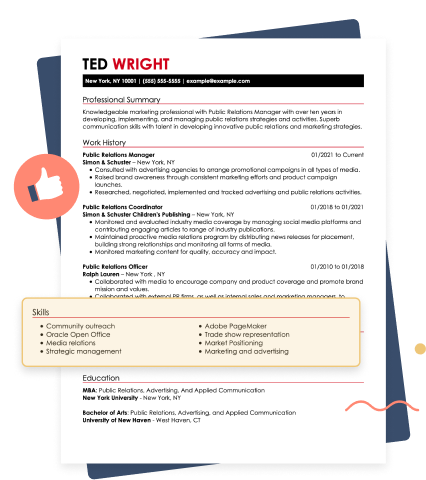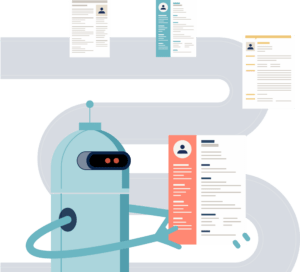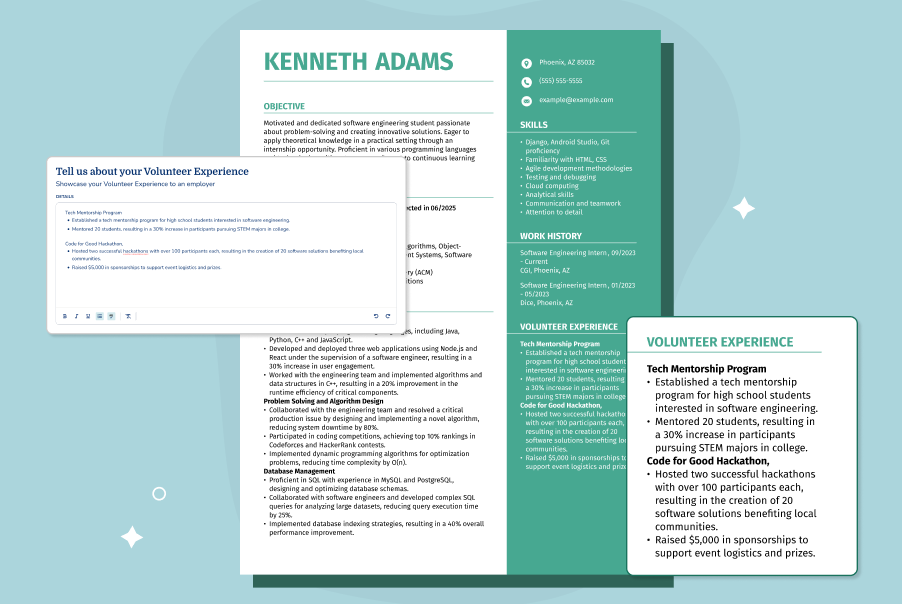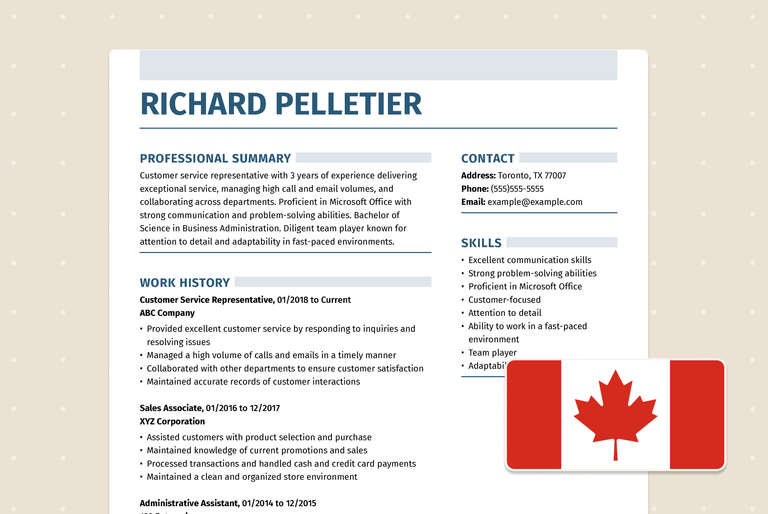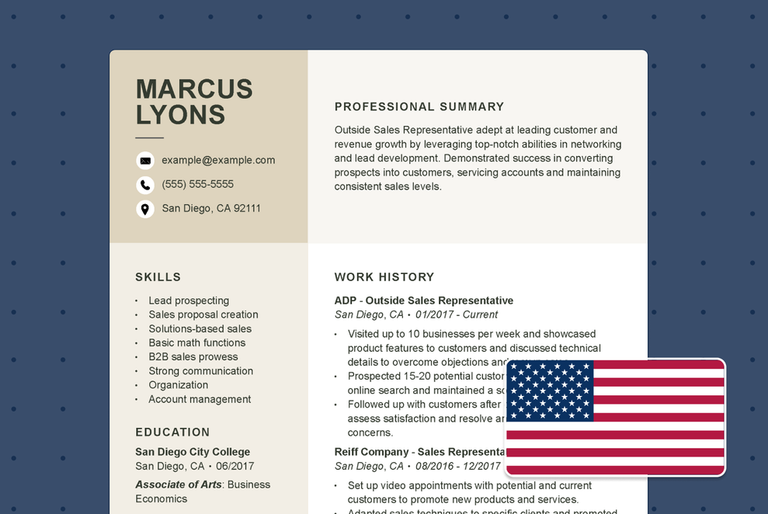How to Make an ATS-Friendly Resume (Templates & Guide)

Our customers have been hired at: *Foot Note
In today’s competitive hiring climate, many employers use applicant tracking systems (ATS) to screen, organize, and store candidate information throughout the hiring process.
According to data from GoodFirms, 90% of Fortune 500 companies use applicant tracking software. That's why it is crucial to have an ATS-compliant resume for every job you apply to.
In this guide, you’ll learn how to create an ATS-friendly resume using the correct keywords and formatting. Start by using our ATS Resume Checker to improve your score and convert your resume to the ATS format.
What Is an Applicant Tracking System?
An applicant tracking system (ATS) is a software application that helps companies manage their recruitment and hiring processes more efficiently.
It is designed to streamline the process of collecting, organizing, and analyzing job applications. Here are a few of the key features and capabilities of applicant tracking systems:
- Job posting management: Distributes job openings to multiple job boards and company career pages
- Resume parsing: Automatically scans and extracts relevant information from resumes, such as skills, experience, and contact details
- Candidate screening: Filters applicants based on predefined criteria, such as keywords, qualifications, or professional experience
- Communication tools: Enables recruiters to communicate with candidates via email or messaging directly from the platform
- Workflow management: Tracks candidates throughout the hiring process, from application to offer or rejection
- Analytics and reporting: Provides insights on hiring metrics, such as time-to-hire, candidate source effectiveness, and other relevant statistics
For recruiters and hiring managers, ATS has become the key differentiator for determining which job candidates to pursue.
To get past the ATS, tailor your resume with relevant keywords and skills from the job description.- Dr. Jasmine Escalera, Career Expert
How does ATS software scan for keywords?
The ATS starts by breaking down resumes into sections like work experience, education, skills, and certifications. Then it converts the content into a structured format, such as plain text.
The software then compares the parsed resume content against a predefined set of keywords and phrases derived from the job description and set by the recruiter or hiring manager.
ATS often include synonyms or variations to avoid missing matches (e.g., "RN" vs. "Registered Nurse"). Some examples of keywords that ATS might scan for include:
- Skills, such as interpersonal skills, coding, leadership
- Certifications (i.e., "BLS Certified," "PMP")
- Education, for example a BA in Communications, PhD, GED, or equivalent
- Former employers like Microsoft, Apple, or Google
- Work history (i.e., marketing, sales, customer service)
- Job titles, such as "Project Manager," "Registered Nurse"
- Action verbs like "managed," "implemented," "collaborated"
More advanced ATS evaluates context, not just the presence of keywords. For example, "Managed a team of 10 nurses" scores higher than just listing "management" under skills.
ATS may also consider keyword placement. For example, keywords in work experience or skills sections may be weighted more heavily than those in a hobbies section.
The ATS assigns scores to resumes based on the number and relevance of keyword matches. Some systems apply weights to prioritize skills or qualifications mentioned in the job description.
The highest-ranking resumes are sent for human review. Hiring managers and recruiters also use ATS to find matching cover letters. See how to write a cover letter for additional tips on optimizing your job application.
How to Make an ATS-Friendly Resume
For an ATS-compliant resume that will impress a hiring manager enough to schedule an interview, you must create a targeted resume for every job you apply to.
Follow the steps below to create a resume that gets into hiring manager's hands:
Step 1Review the job description
Preparation is essential when writing a resume, especially for ensuring that it is ATS-compliant. Start by reviewing the job description and highlighting relevant keywords.
Resume keywords take many forms, such as skills, technical expertise, industry terms, certifications, licenses, and specialized knowledge.
For example, take this hypothetical description for a software engineer job. The highlighted words and phrases are potential keywords you could include in your ATS resume.
SAMPLE JOB DESCRIPTION
ROLE:
Own the technical execution of three cutting-edge web products. Champion the use of best practices—Agile, versioning, and tool usage.
Collaborate with the development team to plan, coordinate, and deliver according to a high-level product roadmap.
RESPONSIBILITIES:
- Create your own themes based on requirements from HTML scratch.
- Understand development best practices and be able to work out and create solutions based on uninformed and sometimes unclear briefs.
- Perform continual maintenance checks to ensure optimal site performance.
- Perform browser compatibility assessments.
REQUIRED SKILLS:
- Should possess expertise in WordPress & HOOKS concepts.
- Decent exposure to WordPress Hierarchy structure.
- Have experience building user interfaces for websites and web applications.
- Well-versed with HTML, MYSQL, Javascript, and jQuery.
If you are writing a resume with no experience, it can help to browse resume examples for jobs in your field to get a better sense of the keywords for your industry and target position.
Step 2Match your qualifications to the job requirements
After you’ve captured all the possible keywords from the job description, match them to your qualifications.
These include relevant hard skills and soft skills, education credentials, volunteer experience, industry expertise, and hands-on work experience that you have.
Be honest about your qualifications; an effective ATS resume is more than just keywords. Potential employers will see through a keyword-loaded resume that does not reflect your true ability to perform the functions of a specific job.
The first step is ensuring that your resume is in the correct format for an ATS to scan and parse the information. Highlighting the key skills mentioned in the job description will help your resume stand out from other applicants.- Toni Frana, Career Expert
Step 3 Incorporate keywords throughout your resume
Sprinkle relevant keywords naturally throughout every section of your resume. We’ve detailed how to include keywords throughout each section below.
Professional summary
Create an ATS-friendly resume summary or objective statement by including keywords pertaining to job-relevant skills, achievements, and the number of years you’ve been in your field.
Let's use the software engineer job above. Take a look at this resume summary example:
Work history
When writing your employment history for an ATS resume, detail the tools, programs, expertise, and technical skills you used to achieve goals for the companies you worked for.
Also discuss the departments and areas of expertise with which you collaborated; all these can be keywords found in a job description.
Let's continue with the same example to create a work experience section:
Digital Spark Media | Remote
March 2020 – Present
- Led the technical execution of three high-traffic WordPress-based web products, building custom themes from HTML, CSS, and JavaScript based on evolving product requirements.
- Applied advanced knowledge of WordPress Hooks and core architecture to create modular, maintainable site components, improving page load speed by 35%.
- Collaborated cross-functionally with product managers, UX/UI designers, and QA engineers to deliver features aligned with a strategic product roadmap using Agile methodologies and version control systems like Git.
- Conducted routine performance audits and implemented solutions to optimize MySQL queries, reducing server response time by 40%.
Employers and applicant tracking systems like a chronological resume format. For employers, it gives them a clear picture of the work you've done, when you did it, and what accomplishments you have relevant to the job they are hiring for. Applicant tracking systems can more easily parse your information when it's in chronological order.- Toni Frana, Career Expert
Skills section
This is the most straightforward section to add keywords in an applicant tracking system resume.
Add your job-matching skills to this section and format them with bullet points.
For example:
- WordPress development
- HTML, CSS, JavaScript, jQuery
- WordPress Hooks & theme architecture
- MySQL
- Git & version control
- Agile methodologies
- Cross-browser compatibility
- Website performance optimization
Optional sections
Optional sections are a great way to highlight job qualifications that are not included in other areas of your resume.
For example, if you add an optional volunteer experience section to your ATS resume, place matching job keywords that did not fit into your work history section there.
Create a section for licenses and certifications and add them to a bulleted list if your job requires them.
Use action verbs whenever possible to describe your qualifications and emphasize accomplishments to give your ATS resume a boost.
How to Check if a Resume Is ATS-Friendly
When an applicant tracking system scans a resume, it compares it to a specific job description and then scores it in what is called a job match rate.
The job match rate is based on how relevant a resume is to the job description stored in the ATS software.
For most ATS tools, a resume scoring 80% or above will pass screening and be forwarded to a hiring manager or recruiter.
Follow the tips below to ensure your resume format is ATS-friendly:
- Use an ATS-resume format: Use one of the three standard resume formats (chronological, combination, or functional).
- Avoid fancy designs: Avoid graphics, images, tables, and columns that the ATS may not read correctly.
- Add standard section titles: For easier parsing, label sections with traditional headings like "Work Experience," "Education," "Skills," and "Certifications."
- Be consistent with dates: Use a standard format for dates (e.g., "Jan. 2022 – Dec. 2023") and place them consistently for each entry.
- Use readable fonts: Choose ATS-friendly resume fonts like Arial, Calibri, Times New Roman, or Verdana.
- Repeat keywords naturally: Integrate keywords throughout your resume, especially in job descriptions, the skills section, and the summary.
- Save as a compatible file type: You can submit your resume as a Word document (.doc or .docx) or a PDF.
Searching for remote jobs? Our sister company, FlexJobs, updates job listings daily. Find verified remote jobs, from remote copywriting jobs to remote sales jobs and everything in between.
ATS-Friendly Resume Templates
Now that you know how to write an ATS resume, building it in an ATS resume template is essential to ensure your job application reaches the hands of hiring managers.
We have over 40 ATS-compatible resume templates for every job and industry. Here’s why our ATS resume templates are ideal for building your resume:
- Created by professional graphic designers
- Ensure you use correct ATS resume formatting
- Feature clean and easy-to-read designs
- Easily customizable to incorporate keywords
- Available in all three standard resume formats
Premium ATS resume templates
Free ATS resume templates
Free ATS Resume Checker
Our ATS Resume Checker analyzes your resume and provides a personalized report on its formatting, word choice, comprehensiveness, and other factors that can affect ATS compatibility.
Your personalized report offers actionable suggestions for improving your resume and increasing your chances of being noticed by recruiters and hiring managers.
Our ATS Resume Checker is just one way our Resume Builder helps job seekers create ATS-friendly resumes. Here’s how our ATS resume checker works:
- Upload your resume to our ATS resume scanner and go to the dashboard to view your resume score.
- Review your personalized report and select “Improve Resume” to implement the recommended fixes.
- Download your ATS-optimized resume in your desired file format and send. Remember to customize your resume for every job you apply for!
Key Takeaways
- Tailor your resume to include job-specific skills, qualifications, and action verbs directly from the posting.
- Avoid graphics, tables, images and fancy designs. Use clear headings and standard, ATS-friendly resume fonts.
- To ensure proper parsing, include headings like "Work Experience," "Education," "Skills," and "Certifications."
- Highlight relevant technical skills, certifications, and measurable accomplishments in your work experience.
- Submit your resume as a Word file or an ATS-compatible PDF. Refer to the job description for file format requirements.
FAQ
Why is my resume getting rejected by ATS?
Here are some common mistakes that could be preventing your resume from passing ATS:
- Using non-standard fonts: Stick to traditional fonts like Arial, Times New Roman, or Calibri to ensure readability.
- Not using relevant keywords: Make sure to include relevant keywords that match the job description. Use industry-specific terms, technical jargon, and action verbs to showcase your skills and experiences.
- Including irrelevant information: Keep your resume focused on the job requirements and relevant qualifications.
- Not proofreading your resume: Always proofread your resume for spelling and grammar errors. ATS may reject your resume if it contains too many errors.
By avoiding these common mistakes, you can increase your chances of getting noticed by recruiters and getting an interview.
Do all companies use ATS for resumes?
Not all companies use applicant tracking systems (ATS) for resumes, but they are increasingly common, especially among larger corporations and organizations with high volumes of job applications.
However, smaller businesses or startups may not utilize ATS due to cost constraints or because they handle their recruitment process manually or with simpler tools.
Nonetheless, it’s a good idea for job seekers to be familiar with ATS since they’re prevalent in the job market today.
How long should a resume be for ATS?
A concise one-page resume or two-page resume is generally recommended for resumes submitted through applicant tracking systems (ATS).
Many ATS have parsing capabilities that extract information from resumes, and overly lengthy documents can be challenging for these systems to process effectively.
Focus on including relevant information that highlights your skills, experiences, and achievements related to the job you’re applying for.
Balancing brevity with substance is key to creating an impactful resume for both ATS and human reviewers.
Does ATS read two-page resumes?
Yes, ATS can read two-page resumes, but it’s essential to ensure the formatting and content are ATS-friendly. Here’s what you need to know:
- ATS reads entire documents: ATS scans the entire document, regardless of resume length, as long as it’s formatted properly and submitted in a compatible file type.
- Consistent formatting across pages: Use clear headings and consistent fonts/styles throughout both pages to ensure ATS parsing doesn’t break.
- Avoid headers or footers for key info: ATS may not read information in headers or footers. Avoid placing contact information or page numbers there.
- The first page is critical: Ensure your most critical skills, accomplishments, and qualifications appear on the first page, as recruiters may prioritize what they see first.
Ultimately, a two-page resume is compatible with ATS as long as it’s well-structured, relevant, and optimized with keywords to pass the system and impress human reviewers.
Can ATS read PDF files?
PDFs created by exporting from word processors (e.g., Microsoft Word, Google Docs) are generally readable by ATS because the text remains selectable and searchable.
If the PDF resume is free of complex designs, graphics, or tables, it’s more likely to be parsed accurately.
You can copy and paste the text from the PDF into a plain text editor like Notepad. If the text is readable, it’s likely ATS-compatible.
Our customers have been hired at:*Foot Note
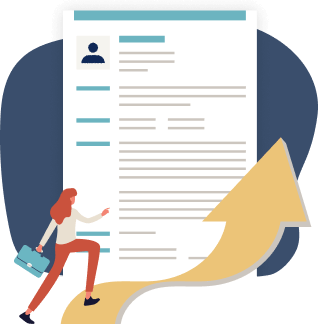
Just three easy steps
- Select a template from our library of professional designs
- Build your resume with our industry-specific bullet points
- Download your resume and send!

Congratulations!
You've taken a big leap forward in your job search by choosing a resume template from MyPerfectResume.

